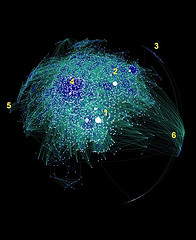Humans are diverse and unpredictable. We create, share, and organize information in an infinity of ways. We’ve even built machines to process it. Yet for all their capacity and speed, using computers to work with information is often awkward and frustrating. We are allowed very little of the spontaneity that characterizes normal human behavior. Our needs must be anticipated in advance by programmers. Far too often we can look, but not touch.
Why isn’t it easier to work with information using a computer?
At Fluidinfo we believe the answer lies in information architecture. A rigid underlying platform inhibits or prevents spontaneity. A new information architecture could be the basis for a new class of applications. It could provide freedom and flexibility to all applications, and these advantages could be passed on to users.
Fluidinfo does not attempt to directly model information accumulation and use in the real world. It simply provides an information architecture that is more flexible than the ones we’re used to. It provides a fairly simple answer to the question of how we might work with information more naturally when using a computer. It does not claim to be the final word on the subject, but points out a fruitful direction for advance. And it provides a concrete implementation that can be used today.
The fruitful direction
The computational world is too read-only, and too tightly controlled. Most of the time we spend using a computer, we are either 1) strictly in read-only mode or 2) using an application that allows us to write, but only in predetermined ways. In contrast, in our normal dealings with the natural world, when using our brains, we are never in read-only mode. We are constantly processing information and adding (i.e., writing) to our mental models. I’m talking about everyday things, like noticing something and remembering that you noticed. Or seeing something you like, and being able to recall that fact later. Even in these trivial acts we are in some sense writing—laying down memories that can later be recalled, sorted amongst, shared, organized, merged, or put aside for long periods or even forever.
In thinking about this extreme fluidity, I find it illustrative to consider how we work with concepts. As I wrote in Kaleidoscope: 10 takes on Fluidinfo:
Concepts are very fluid: they don’t have owners, you don’t ask for permission to add to them, they have no formal structure or central piece of content, they can be organized in many ways, and they have no pre-defined set of qualities or attributes. Exactly the same can be said of Fluidinfo objects.
The fruitful direction—and the mission of Fluidinfo, if I may be so grandiose and dramatic—is to engineer an information architecture with a fluidity similar to that of concepts, in order to make the world more writable. The question (and the point of this posting) is how?
Objects without owners
The answer is actually very simple: Fluidinfo provides support for information objects that do not have top-level owners. These objects are comprised of tags (with values), for which there is a flexible and secure permissions model. Because the objects don’t have owners, anyone, or any application, can add tags to any object it can find. These objects have all the nice properties of concepts mentioned above.
That’s it?
While there’s a lot more to Fluidinfo than having objects with no owners, this single change is the key to the architecture and is responsible for its generality and flexibility. It’s almost embarrassingly simple.
It takes a while for the implications of this twist to sink in. I’m not going to go into the details in this post. I’ll just point out that a simple change in representation can have a surprisingly profound effect. I’ve already written about this, though without giving details of Fluidinfo.
I’m fascinated by representation and its role in problem solving. How can such a simple piece of mental jujitsu result in fundamental change? I’ll describe the consequences in later posts. There are several of them, and I think they’re important. For now though, if you’re interested, please follow the link above to see some simple examples of the power of changing an underlying representation.






